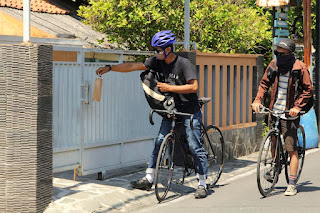Tosca, my Mercian fixed-gear bike, has some NJS-approved parts on it. I have never made any effort, however, to make it or any other bike I’ve owned NJS-compliant.
Parts and bikes with the designation are approved for use in keirin, a form of track racing in Japan. As I understand, NJS standards were created so that no racer is at an unfair advantage or disadvantage because of his equipment. That is why NJS- approved equipment perpetuates standards from the 1970’s and ‘80’s: Frames are steel and wheels have 36 spokes.
Because bets are placed on riders, officials also want to ensure that a race isn’t decided by broken equipment. Thus, NJS standards emphasize strength and reliability.
A consequence of NJS standards is that they don’t make for putting together the lightest possible bikes. That is why, for example, Olympic track racers don’t ride NJS equipment.
Those racers include Australian Alex Porter. He and his fellow Team Pursuit teammates were seen as possible gold medal winners in Tokyo. That is, until he came crashing down on the track and sliding across the boards. That ended Australia’s qualifying run after a minute. The team was able to make a second attempt, in which they finished fifth. Now they have a difficult task ahead of them if they are to contend for even a bronze medal.
What sent Porter, and his team’s hopes, crashing down? A broken handlebar.
He was riding an Argon 18 bike. Argon VP Martin Faubert said, “While Argon 18 has designed a handlebar for the bike, and provided that bar to the team, it was not our bar in use during the incident.”
Somehow I think NJS standards also preclude statements like that from executives of Sugino, MKS and other companies that make equipment for Kerin.


